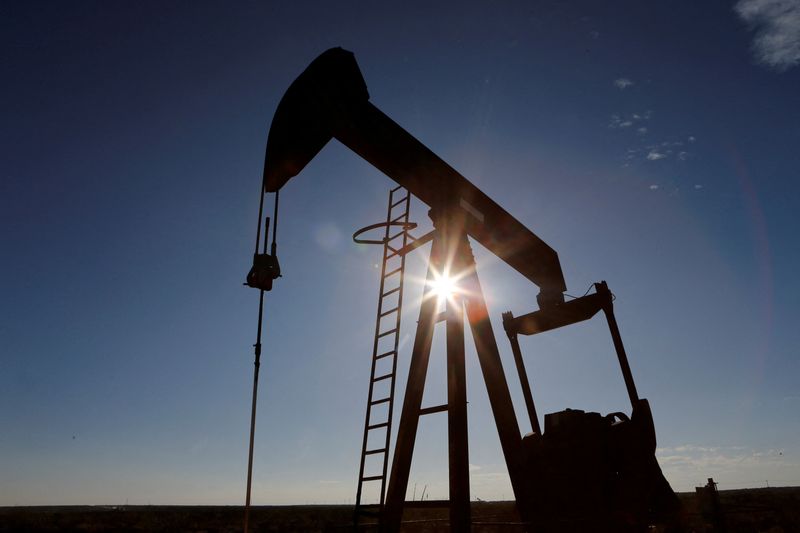Commodities
Oil drops slightly on China demand concerns but records weekly gain


© Reuters. FILE PHOTO: The sun is seen behind a crude oil pump jack in the Permian Basin in Loving County, Texas, U.S., November 22, 2019. REUTERS/Angus Mordant/File Photo
By Nicole Jao
NEW YORK (Reuters) -Oil prices settled slightly lower on Friday but recorded a weekly gain as Middle East tensions and disruptions to oil output offset concerns about the Chinese and global economies.
futures settled 54 cents lower at $78.56 a barrel. U.S. West Texas Intermediate crude fell 67 cents to settle at $73.41.
For the week, Brent gained about 0.5% while the U.S. benchmark rose over 1%.
In China, slower-than-expected economic growth in the fourth quarter raised doubts about forecasts that demand there will drive global oil growth in 2024.
“The Chinese equity market this week dropped to near a five-year low,” said Bob Yawger, director of energy futures at Mizuho Bank. The indication for weaker demand drove crude prices down on Friday.
In the Middle East, geopolitical risks supported prices for the week.
On Friday, tensions escalated in Gaza as Israeli forces pushed south against Hamas militants, while earlier in the week, the U.S. launched new strikes against Houthi anti-ship missiles aimed at the Red Sea.
Although conflict in the Middle East has not shut any oil production, supply outages continued in Libya.
In the U.S., about 30% of oil output in North Dakota, the country’s third largest producing state, remained shut due to extreme cold, the state’s pipeline authority said on Friday.
Output had been cut by some 700,000 bpd, or more than half, midweek.
It could take a month for production to return to normal levels, the state regulator said on Friday.
“Supply disruptions remain an upside risk but there are downside risks too, including the global economy,” Craig Erlam, analyst at brokerage OANDA, said.
Meanwhile, the number of oil rigs operating in the U.S., an early indictor of production, fell by two to 497 this week, Baker Hughes said on Friday.
The International Energy Agency this week raised its 2024 global demand forecast, but its projection is half that of producer group OPEC. The Paris-based agency also said that – barring significant disruptions to flows – the market looked reasonably well supplied in 2024.
“The forecast for global oil demand growth remains unclear, with stakeholders and research institutions providing widely differing projections,” analyst Bjarne Schieldrop of SEB said.
The premium of the first-month Brent contract to the six-month contract rose to as much as $2.15 a barrel on Friday, the highest since November. This structure, called backwardation, indicates a perception of tighter supply for prompt delivery.
Money managers cut their net long futures and options positions in the week to Jan. 16, the U.S. Commodity Futures Trading Commission (CFTC) said on Friday.
Commodities
Oil prices rise; U.S. crude inventories plunge, Russia-Ukraine truce eyed
Commodities
India’s Reliance to stop buying Venezuelan oil over US tariffs, sources say
Commodities
Oil prices climb on Venezuela supply worries

 Forex3 years ago
Forex3 years agoForex Today: the dollar is gaining strength amid gloomy sentiment at the start of the Fed’s week

 Forex3 years ago
Forex3 years agoUnbiased review of Pocket Option broker

 Forex3 years ago
Forex3 years agoDollar to pound sterling exchange rate today: Pound plummeted to its lowest since 1985

 Forex3 years ago
Forex3 years agoHow is the Australian dollar doing today?

 Cryptocurrency3 years ago
Cryptocurrency3 years agoWhat happened in the crypto market – current events today

 World3 years ago
World3 years agoWhy are modern video games an art form?

 Commodities3 years ago
Commodities3 years agoCopper continues to fall in price on expectations of lower demand in China

 Economy3 years ago
Economy3 years agoCrude oil tankers double in price due to EU anti-Russian sanctions



























